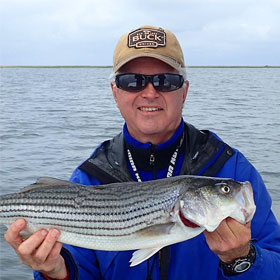14 Important Things To Know About Safe Wading Techniques
By Ken Schultz
Aug 06, 2019
An enjoyable and productive day of fishing while in the water, particularly in rivers and current, can be achieved if you follow these safe wading techniques.
If you’re in the water while fishing, you need to know and practice safe wading techniques. While conditions differ among stream, river, pond, lake, or coastal waters, there’s no substitute for experience and proceeding carefully. Always consider depth, water speed, bottom configuration, and whether it is prudent to wade in or through fast or deep areas at all.
Here are fourteen tips for safe wading techniques.- Go slow. Make sure that your foot is firmly planted and stable before taking the next step. Crab-like steps are much better than long strides. Concentrate on what is directly in front of you.
- Wearing polarized sunglasses helps make underwater terrain more visible, although the deeper you wade and the murkier the water, the less this helps. In clear water the right polarized sunglasses are a great aid.
- One of the first things that anyone with experience will tell you about how to fish in a river with a strong current is to scout an area that you intend to wade across before starting to do so. Often you’ll find a better, usually shallower, route a little distance upstream or downstream.
- Do not cast and wade simultaneously. Get into position and then cast. This is one of the top river fishing tips for beginners, who are always eager to keep casting while on the move.
- Beware of rocks. Don’t hop or leap from one large rock to another; place your feet between rocks instead of on top of them. Don’t wade in the turbulent water upstream of a large rock, and beware of deep holes below large rocks.
- In tailwater rivers, beware of rising water; dam releases can suddenly raise the water level. If that happens, waste no time getting to shore.
- Plan each step and move slowly by shuffling each foot along rather than lifting it.
- In current, wade with your body and feet sideways to the flow. Even a slight turn in fast water can spin you or knock you over. Wade across at an angle, preferably slightly quartered upstream.
- Using a wading staff or stick is helpful. It acts as a stabilizing third leg and is also valuable for probing depth and poking for objects. If the current is swift, place the staff upstream.
- Without a stick, you can use your fishing rod to help stabilize you in deep swift current, especially when you start to feel unbalanced or are about to stumble or fall. Hold the rod in your downstream hand and keep it pointed directly downstream. Place the tip section in the current to act as a stabilizer. In the worst cases, use both a staff in your upstream hand and the rod in your downstream hand.
- Don’t relax once you get across a rough spot, or are about to leave the water. Many people fall on their way out of the water by taking their last steps for granted.
- If you head into soft-bottomed areas, do not keep going forward; you may find your feet so deeply buried in muck that suction keeps them mired. Retreat to firmer ground and find a better route.
- When you hook a strong fish, gradually retreat from deep water and get to shore. You can follow a fish easier if necessary from the shallows where you have more maneuverability, and also can effect a higher rod angle.
- If you wade in areas where dangerous creatures, especially alligators, are present, always be watchful and mindful, since you’re in their element and a quick exit is often impossible. Keeping fish on a stringer, for instance, while you wade, may not be a good idea.
Safe wading techniques contribute to a good day of fishing, so don’t ignore or overlook them. Before planning your next fishing trip buy your fishing licence.









